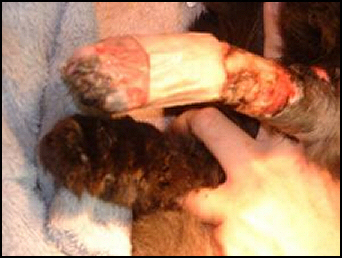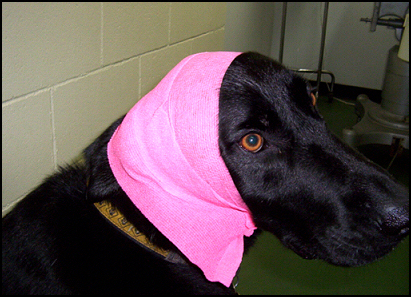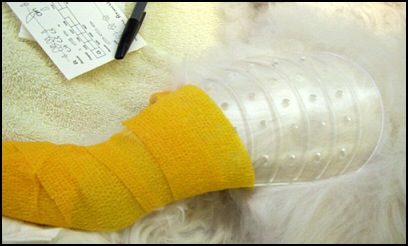How To Properly Apply a Bandage and Splint On Your Dog Or Cat
You can cause serious harm to your dog or cat if a bandage or splint is not applied properly. In some instances, wounds and injuries need to be bandaged. The problem arises when your pet decides to excessively lick the injury, causing further irritation. Using an Elizabethan Collar or covering the area up with a bandage can prevent this. This article will show you the exact materials that are needed, including the exact steps to take to put the bandage or splint on the right way.
Materials
White Tape: This can be used as a first layer to prevent slipping, and as a final layer of bandaging. The tape can be purchased at any pharmacy.
Sterile Non-Stick Pads: Telfa Pads are ideal. IF this is an emergency bandage, then use a small piece of cloth, but apply K-Y jelly first so the cloth doesn’t stick.
Cotton padding: For injuries that need support, such as ligament injuries or fractures, I apply cotton padding as well. You can purchase large cotton rolls at any pharmacy. An emergency padding can easily be a small towel that is wrapped around the leg.
Gauze: Roll gauze is the clingy material that stretches and has holes in it. It can be purchased at any pharmacy. In an emergency, you can use Panty Hose.
Tape: The last layer on a bandage is the adhesive that secures the pad and gauze in place. I usually use a product called Vet-Wrap; it stretches and sticks to the gauze. In an emergency, you can use Duct Tape, Saran Wrap, anything that will stick and hold the bandage material in place.
The key to applying a bandage is to make the bandage tight enough that it won’t slip, but NOT too tight so that it cuts off circulation. If the bandage is TOO tight, you will see the digits swell (the area below the bandage). I always try and leave a few toes exposed so I can check this. If the bandage is too tight, then the toes swell and spread apart.
The other important part of bandage care is keeping the bandage dry. If it gets wet it will cause serious skin irritation and infection. If it gets wet, then You MUST change it. Keep the bandage covered with a plastic bag; ask your local veterinarian for an empty IV Fluid Bags- they are made of heavy-duty plastic and work great.
Leg Bandage
The most common area to bandage is the leg.
Clean the wound properly.
Apply 2 strips of white “hospital” tape to the inside and outside of the leg.
Apply the non-stick Telfa pad to the wound.
Wrap the leg with gauze, beginning at the toes, but leave the toes exposed. Overlap the gauze as you wrap up the leg. Make the gauze wrap firm to keep the Pad in place, extend up to the next joint. If your dog has a wound on his paw, I would wrap to above the wrist.
Cover the gauze with Vet Wrap or Tape. Once again make it firm, but not too firm. Keep the toes exposed to check for swelling.
Head Bandage
The head is another area that may need to be bandaged, especially in the case of an injured ear that won’t stop bleeding.
This is best accomplished by folding the earflaps on top of the head, then wrapping gauze and tape around the head covering the ears.
Another option is to use pantyhose; I find it remains in place much better.
Keep the bandage in front of the eyes, and ensure that you can stick one finger underneath the bandage at the neck.
Body Bandage
In the event that you need to cover a wound on the chest or abdomen, there are a couple of ways.
T-shirt technique: Put your dog’s front legs through the armholes, and cover the rest of his body with the shirt. You can then apply Tape to secure the back of the T-shirt.
Panty Hose: A second method is to cover your pet’s chest or abdomen with pantyhose. Pull it over your pet’s head and cover the affected area.
Splints
A splint needs to be applied if you suspect that your pet has a fracture. This would be an emergency measure, until a veterinarian examines your pet.
The joints above and below the break must be covered. Only breaks lower on the limb can be effectively splinted.
Apply 2 strips of white “hospital” tape to the inside and outside of the leg.
Rigid material. You can purchase splints from your veterinarian. In an emergency use cardboard, rolled newspaper or bubble wrap.
Wrap the leg with gauze, beginning at the toes, but leave the toes exposed. Overlap the gauze as you wrap up the leg. Make the gauze wrap firm to keep the splint in place, extend up to the next joint. If your dog has a fracture on his wrist, I would wrap to above the knee.
Cover the gauze with Vet Wrap or Tape. Once again make it firm, but not too firm. Keep the toes exposed to check for swelling.
Heal Your Pet At Home!
Best Wishes,
Dr Andrew Jones, DVM



Hello, my 14 year old male dog (Little Bear) 1/2 pit1/2choc lab has loss strength and mobility in his hind legs. I’d like to ace bandage them for support on times when we go for walks or ride in the care. He’s so loved. Thank you for sharing your expertise!
You can try adding joint supplements into it’s diet and check it here:
https://shop.veterinarysecrets.com/supplements/joint-support.html